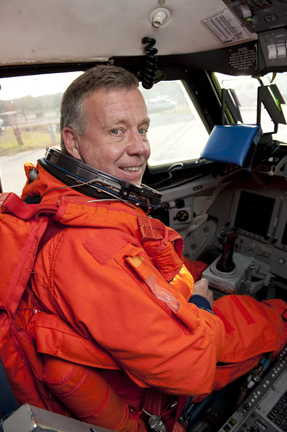Shuttle countdown proceeding smoothly
By WILLIAM HARWOOD
CBS News
KENNEDY SPACE CENTER, Fla. -- The shuttle Discovery's countdown is ticking smoothly toward launch Thursday on a space station re-supply mission. There are no technical problems of any significance at pad 39A and forecasters are continuing to predict an 80 percent chance of good weather.
"At the moment, everything's going well with the countdown, we all take immense pride in the work and the accomplishments of the team and of this vehicle, and we're all looking forward to a successful launch on Thursday," NASA Test Director Steve Payne told reporters Tuesday.
Shuttle weather officer Kathy Winters repeated the forecast she gave Monday, saying the odds are 80 percent "go" Thursday, dropping to 70 percent and 60 percent Friday and Saturday as a front moves through the area.
Working by remote control, engineers worked Tuesday to pump liquid oxygen and hydrogen aboard the shuttle to power the ship's three electricity producing fuel cells. After loading, the team planned to drain 120 pounds of liquid oxygen to fine tune the orbiter's weight and improve its "ascent performance margin."
Main engine preparations will begin early Wednesday, followed by avionics system checkouts and activation of the shuttle's communications systems. A protective gantry will be rotated away from the shuttle at 8 p.m. Wednesday, exposing Discovery to view and clearing the way for fueling.
The three-hour fuel loading procedure is scheduled to begin at 7:25 a.m. Thursday. Shortly after the tank is topped off with more than 500,000 gallons of liquid oxygen and hydrogen rocket fuel, the European Space Agency's Automated Transfer Vehicle 2, an unmanned cargo ship, is scheduled to complete a computer-controlled docking at the International Space Station's aft port.
The ATV-2, also known as Johannes Kepler, was launched Feb. 16 by an Ariane 5 rocket from Kourou, French Guiana. It is carrying more than 7 tons of supplies and equipment and any major problems getting the craft docked at the station could impact Discovery's launch.
But the cargo ship is operating flawlessly -- two rendezvous rocket firings were carried out early Tuesday -- and NASA managers do not expect any problems.
Back on Earth, engineers plan to pay special attention to Discovery's external tank after it is loaded with super-cold propellants, on the lookout for any cracks in the tank's foam insulation that might indicate an underlying fracturet.
Discovery was grounded in the wake of a Nov. 5 launch scrub because of small cracks near the tops of several rib-like "stringers" in the central intertank section where they meet a massive flange that supports the upper liquid oxygen tank. Testing and analysis showed the cracks most likely were the result of temperature-induced stress on stringers made with an aluminum-lithium alloy that was more brittle than usual.
The existing cracks were repaired and the top few inches of most of the 108 stringers used in the intertank were beefed up with so-called "radius blocks" that were riveted into place on top of the stringer attachment "feet" to make them less susceptible to fractures.
Engineers do not expect any additional problems, but an inspection team sent to the pad after fueling to look for signs of ice or anything else that could cause a problem during ascent will be on the lookout for foam cracks, photographing the stringer/flange area for detailed analysis before final clearance to launch.
Discovery is scheduled for liftoff at 4:50:24 p.m. EST (GMT-5) Thursday. With just three shuttle flights left on NASA's manifest before the fleet is retired this summer, Payne said he expects a big turnout.
"It's generated a lot of interest," he said. "The last few missions, people are starting to realize they either see one now or they don't get to see one at all. We've had some pretty good crowds come the last couple of times, we expect an equally large crowd (Thursday).
"It ought to be a good show. It's a good time of day, it's an excellent vehicle and it's always impressive to watch. So I'm sure we'll have a full house."
CBS News
KENNEDY SPACE CENTER, Fla. -- The shuttle Discovery's countdown is ticking smoothly toward launch Thursday on a space station re-supply mission. There are no technical problems of any significance at pad 39A and forecasters are continuing to predict an 80 percent chance of good weather.
 |
| Discovery commander Steven Lindsey smiles for the camera from the cockpit of a NASA jet modified to handle like a space shuttle on final approach. (Credit: NASA) |
Shuttle weather officer Kathy Winters repeated the forecast she gave Monday, saying the odds are 80 percent "go" Thursday, dropping to 70 percent and 60 percent Friday and Saturday as a front moves through the area.
Working by remote control, engineers worked Tuesday to pump liquid oxygen and hydrogen aboard the shuttle to power the ship's three electricity producing fuel cells. After loading, the team planned to drain 120 pounds of liquid oxygen to fine tune the orbiter's weight and improve its "ascent performance margin."
Main engine preparations will begin early Wednesday, followed by avionics system checkouts and activation of the shuttle's communications systems. A protective gantry will be rotated away from the shuttle at 8 p.m. Wednesday, exposing Discovery to view and clearing the way for fueling.
The three-hour fuel loading procedure is scheduled to begin at 7:25 a.m. Thursday. Shortly after the tank is topped off with more than 500,000 gallons of liquid oxygen and hydrogen rocket fuel, the European Space Agency's Automated Transfer Vehicle 2, an unmanned cargo ship, is scheduled to complete a computer-controlled docking at the International Space Station's aft port.
The ATV-2, also known as Johannes Kepler, was launched Feb. 16 by an Ariane 5 rocket from Kourou, French Guiana. It is carrying more than 7 tons of supplies and equipment and any major problems getting the craft docked at the station could impact Discovery's launch.
But the cargo ship is operating flawlessly -- two rendezvous rocket firings were carried out early Tuesday -- and NASA managers do not expect any problems.
 |
| A NASA Shuttle Training Aircraft, or STA, completes an approach to the shuttle runway and climbs away for another practice landing. (Credit: NASA) |
Discovery was grounded in the wake of a Nov. 5 launch scrub because of small cracks near the tops of several rib-like "stringers" in the central intertank section where they meet a massive flange that supports the upper liquid oxygen tank. Testing and analysis showed the cracks most likely were the result of temperature-induced stress on stringers made with an aluminum-lithium alloy that was more brittle than usual.
The existing cracks were repaired and the top few inches of most of the 108 stringers used in the intertank were beefed up with so-called "radius blocks" that were riveted into place on top of the stringer attachment "feet" to make them less susceptible to fractures.
Engineers do not expect any additional problems, but an inspection team sent to the pad after fueling to look for signs of ice or anything else that could cause a problem during ascent will be on the lookout for foam cracks, photographing the stringer/flange area for detailed analysis before final clearance to launch.
Discovery is scheduled for liftoff at 4:50:24 p.m. EST (GMT-5) Thursday. With just three shuttle flights left on NASA's manifest before the fleet is retired this summer, Payne said he expects a big turnout.
"It's generated a lot of interest," he said. "The last few missions, people are starting to realize they either see one now or they don't get to see one at all. We've had some pretty good crowds come the last couple of times, we expect an equally large crowd (Thursday).
"It ought to be a good show. It's a good time of day, it's an excellent vehicle and it's always impressive to watch. So I'm sure we'll have a full house."